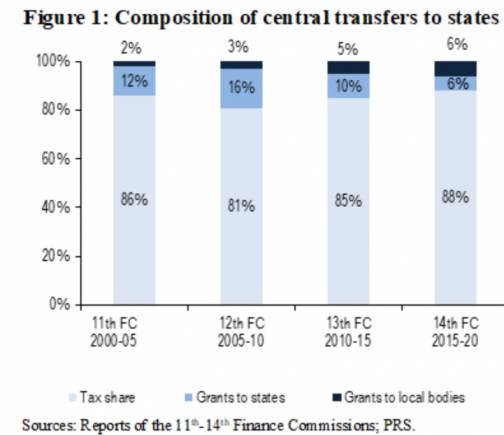In November 2017, the 15th Finance Commission (Chair: Mr N. K. Singh) was constituted to give recommendations on the transfer of resources from the centre to states for the five year period between 2020-25. In recent times, there has been some discussion around the role and mandate of the Commission. In this context, we explain the role of the Finance Commission.
What is the Finance Commission?
The Finance Commission is a constitutional body formed every five years to give suggestions on centre-state financial relations. Each Finance Commission is required to make recommendations on: (i) sharing of central taxes with states, (ii) distribution of central grants to states, (iii) measures to improve the finances of states to supplement the resources of panchayats and municipalities, and (iv) any other matter referred to it.
Composition of transfers: The central taxes devolved to states are untied funds, and states can spend them according to their discretion. Over the years, tax devolved to states has constituted over 80% of the total central transfers to states. The Centre also provides grants to states and local bodies which must be used for specified purposes. These grants have ranged between 12% to 19% of the total transfers.

Over the years the core mandate of the Commission has remained unchanged, though it has been given the additional responsibility of examining various issues. For instance, the 12th Finance Commission evaluated the fiscal position of states and offered relief to those that enacted their Fiscal Responsibility and Budget Management laws. The 13th and the 14th Finance Commission assessed the impact of GST on the economy. The 13th Finance Commission also incentivised states to increase forest cover by providing additional grants.
15th Finance Commission: The 15th Finance Commission constituted in November 2017 will recommend central transfers to states. It has also been mandated to: (i) review the impact of the 14th Finance Commission recommendations on the fiscal position of the Centre; (ii) review the debt level of the Centre and states, and recommend a roadmap; (iii) study the impact of GST on the economy; and (iv) recommend performance-based incentives for states based on their efforts to control population, promote ease of doing business, and control expenditure on populist measures, among others.
Why is there a need for a Finance Commission?
The Indian federal system allows for the division of power and responsibilities between the Centre and states. Correspondingly, the taxation powers are also broadly divided between the Centre and states (Table 1). State legislatures may devolve some of their taxation powers to local bodies.

The Centre collects majority of the tax revenue as it enjoys scale economies in the collection of certain taxes. States have the responsibility of delivering public goods in their areas due to their proximity to local issues and needs.
Sometimes, this leads to states incurring expenditures higher than the revenue generated by them. Further, due to vast regional disparities some states are unable to raise adequate resources as compared to others. To address these imbalances, the Finance Commission recommends the extent of central funds to be shared with states. Prior to 2000, only revenue income tax and union excise duty on certain goods was shared by the centre with states. A Constitution amendment in 2000 allowed for all central taxes to be shared with states.
Several other federal countries, such as Pakistan, Malaysia, and Australia have similar bodies which recommend the manner in which central funds will be shared with states.
Tax devolution to states
The 14th Finance Commission considerably increased the devolution of taxes from the centre to states from 32% to 42%. The Commission had recommended that tax devolution should be the primary source of transfer of funds to states. This would increase the flow of unconditional transfers and give states more flexibility in their spending.

The share in central taxes is distributed among states based on a formula. Previous Finance Commissions have considered various factors to determine the criteria such as the population and income needs of states, their area and infrastructure, etc. Further, the weightage assigned to each criterion has varied with each Finance Commission.
The criteria used by the 11 th to 14th Finance Commissions are given in Table 2, along with the weight assigned to them. State level details of the criteria used by the 14th Finance Commission are given in Table 3.

- Population is an indicator of the expenditure needs of a state. Over the years, Finance Commissions have used population data of the 1971 Census. The 14th Finance Commission used the 2011 population data, in addition to the 1971 data. The 15th Finance Commission has been mandated to use data from the 2011 Census.
- Areais used as a criterion as a state with larger area has to incur additional administrative costs to deliver services.
- Income distanceis the difference between the per capita income of a state with the average per capita income of all states. States with lower per capita income may be given a higher share to maintain equity among states.
- Forest cover indicates that states with large forest covers bear the cost of not having area available for other economic activities. Therefore, the rationale is that these states may be given a higher share.
Grants-in-Aid
Besides the taxes devolved to states, another source of transfers from the Centre to states is grants-in-aid. As per the recommendations of the 14th Finance Commission, grants-in-aid constitute 12% of the central transfers to states. The 14th Finance Commission had recommended grants to states for three purposes: (i) disaster relief, (ii) local bodies, and (iii) revenue deficit.
(The writer is an associate with PRS Legislative Research)

